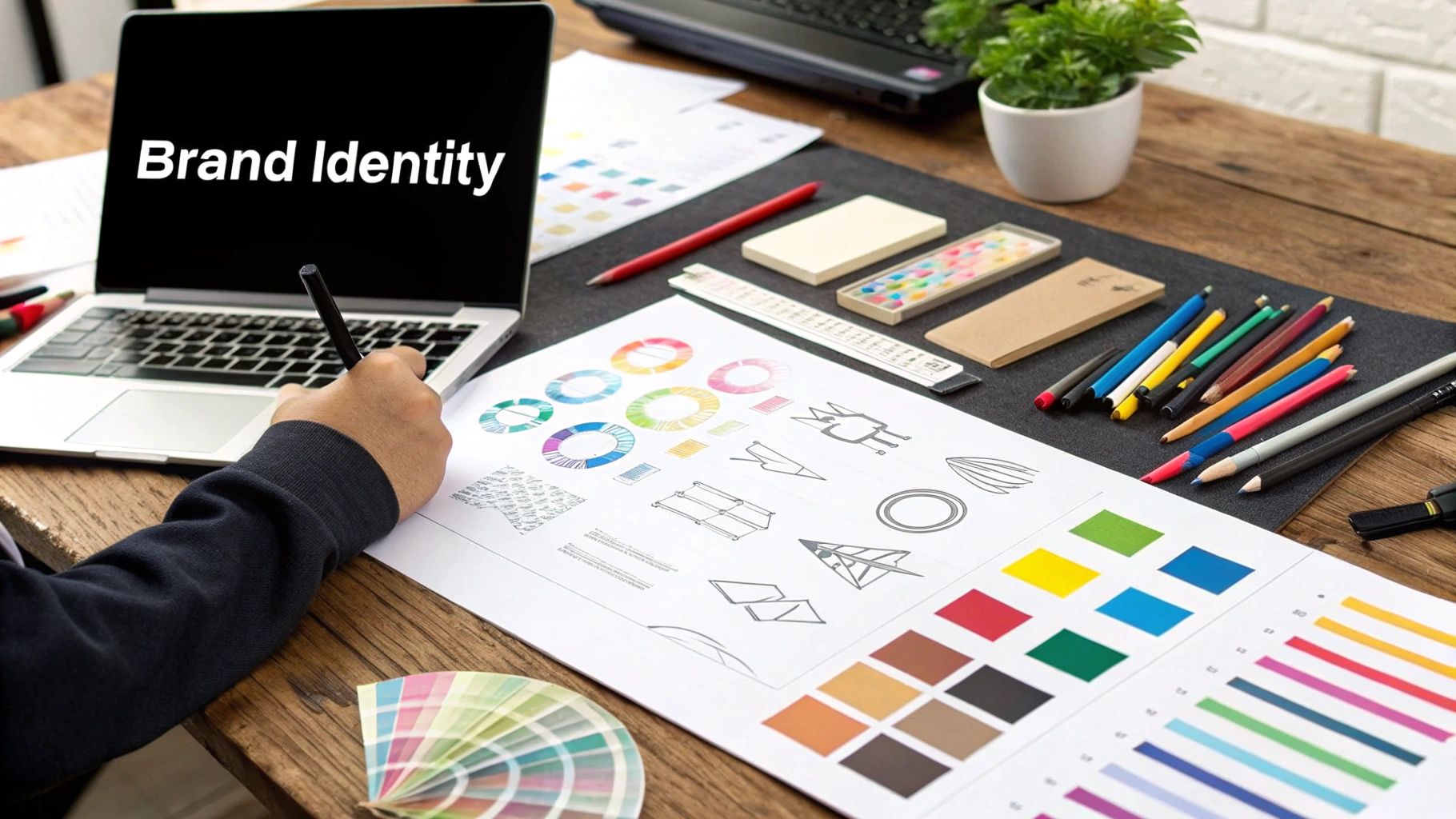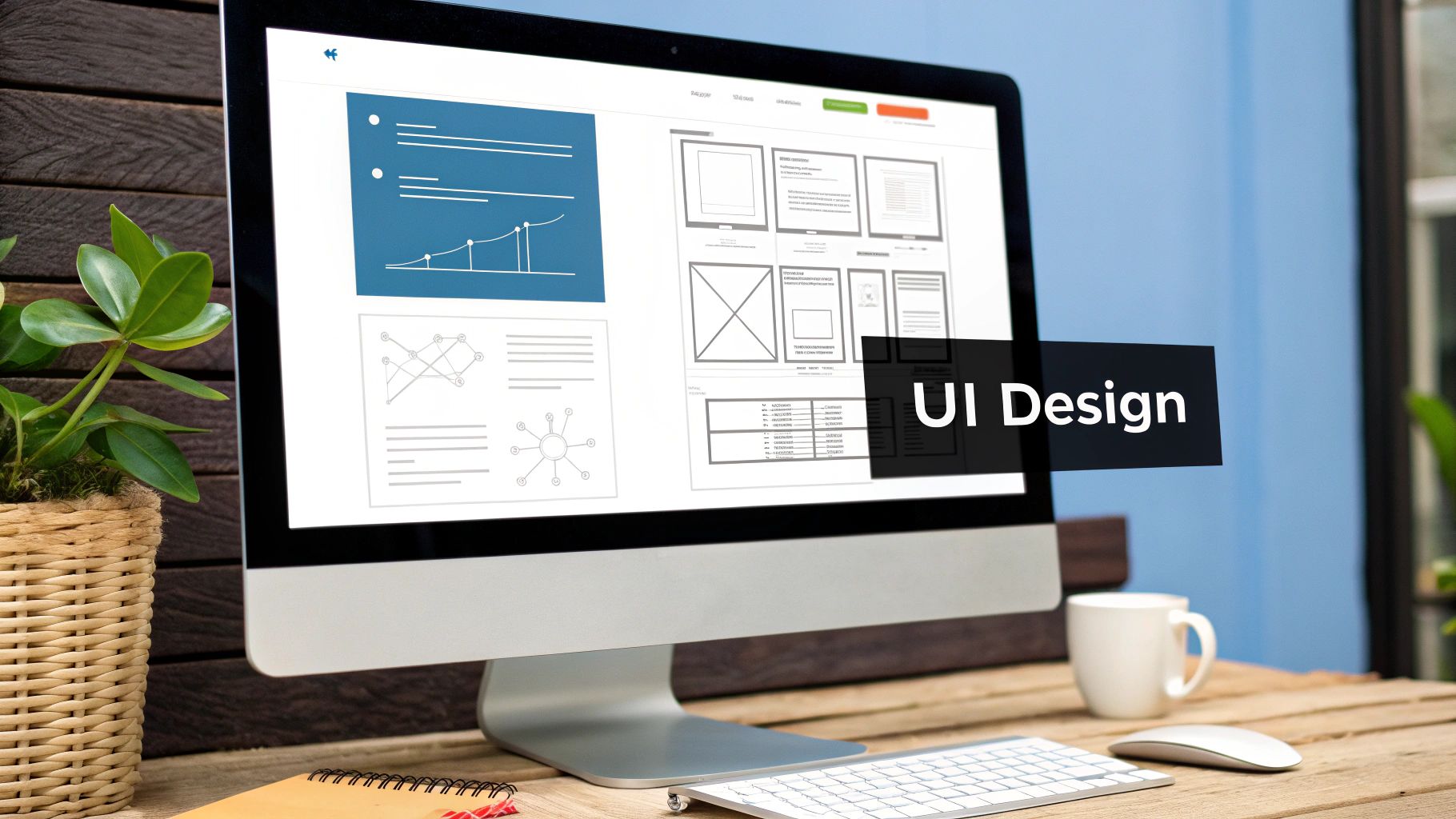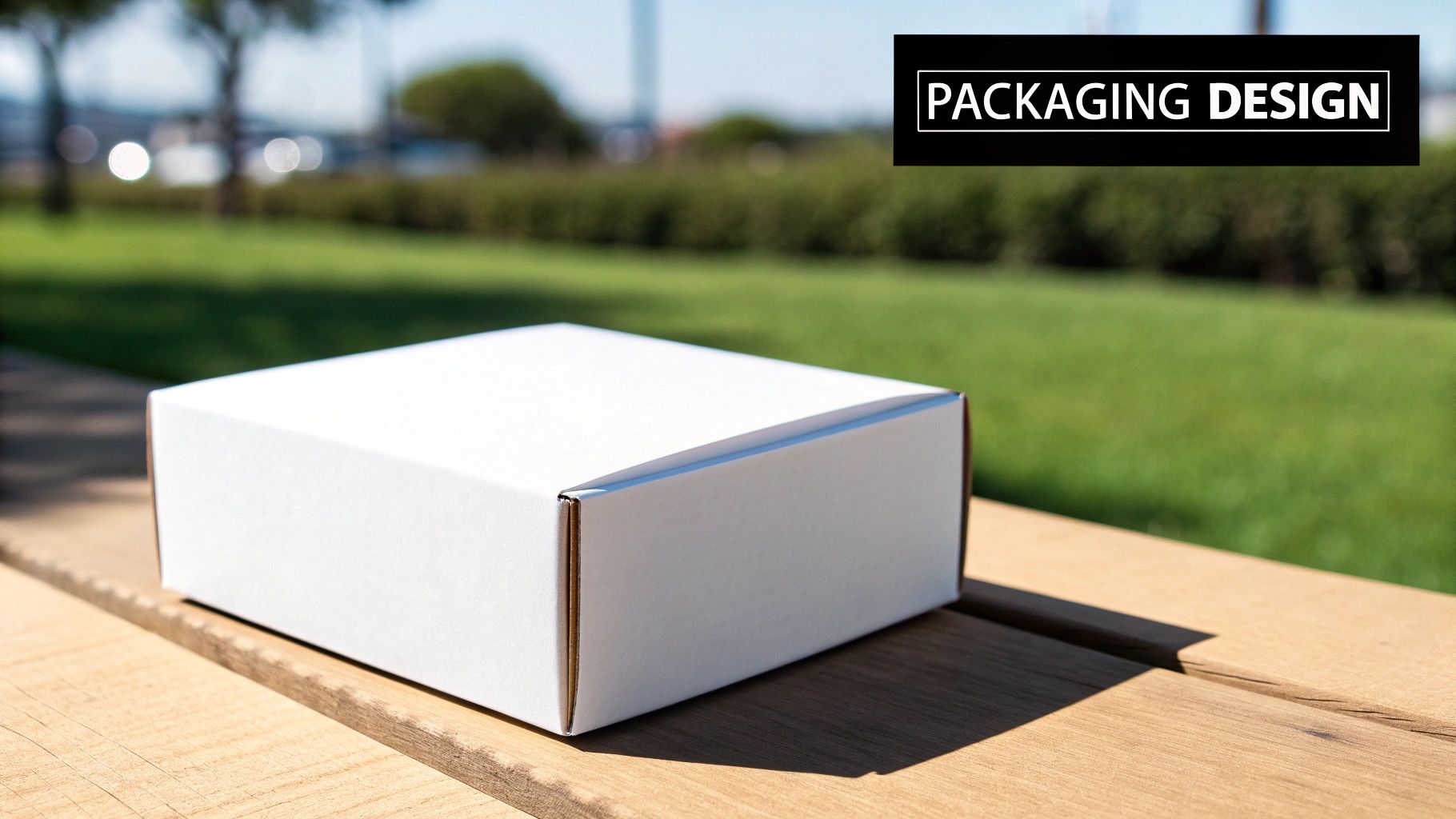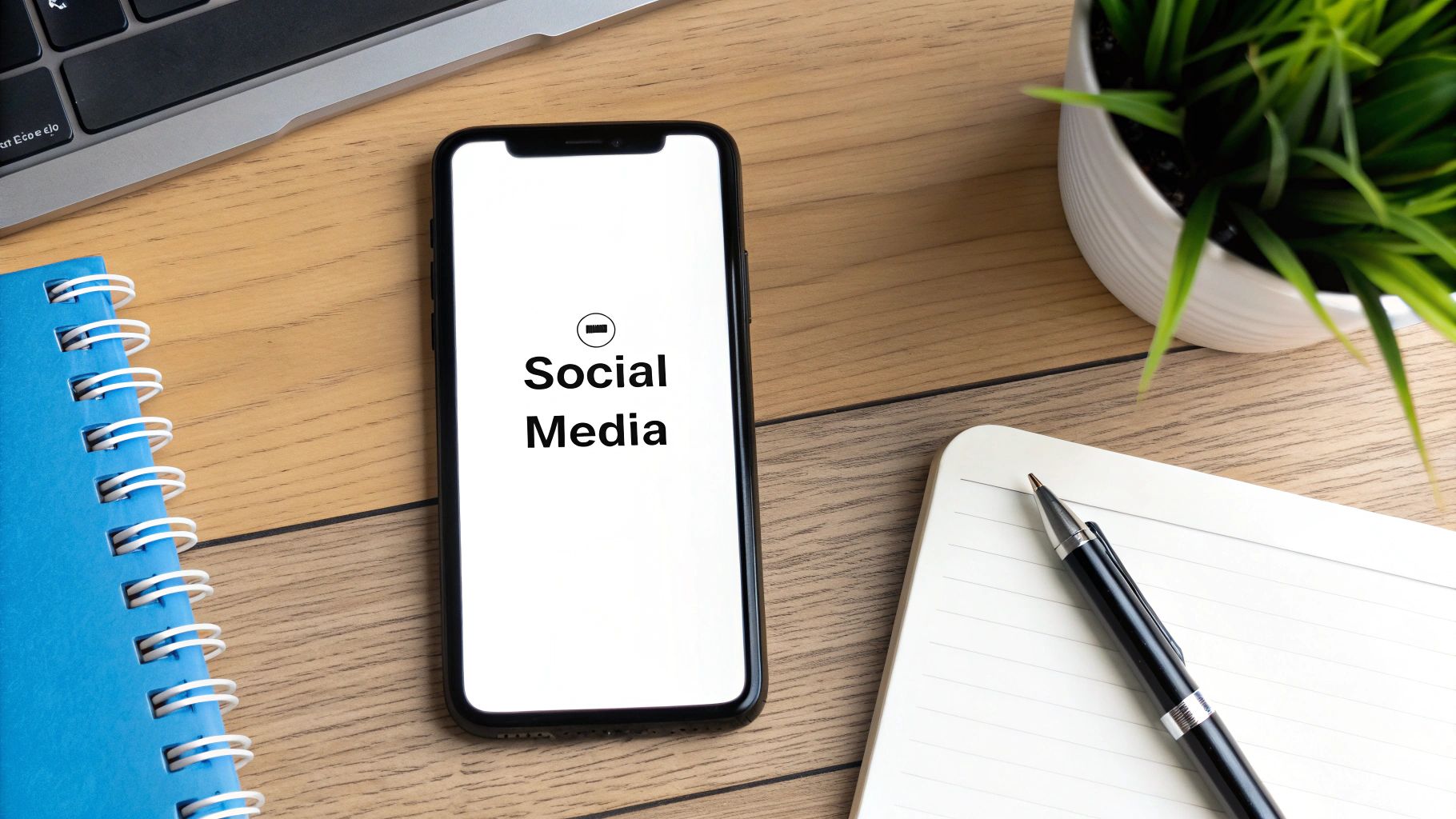In the dynamic world of design, a standout portfolio is your most powerful tool. It's more than a gallery; it's a testament to your skills, creativity, and strategic thinking. But finding the right graphic design projects to build or refresh that portfolio can be a significant challenge. This roundup cuts through the noise, offering ten diverse, high-impact project ideas designed to stretch your creative muscles and impress potential clients or employers.
We'll explore everything from foundational brand identity systems and intricate mobile app interfaces to tangible packaging and print campaigns. Each item provides the insights, techniques, and practical examples you need to create work that truly stands out. To effectively tackle these diverse design challenges, understanding and utilizing the right resources is paramount. Exploring the best graphic design tools for designers can equip you with the software and assets needed to execute these concepts professionally and efficiently.
Whether you're a seasoned professional looking for a new challenge or a rising star ready to make your mark, these projects offer a clear roadmap to building a more compelling and effective portfolio. Consider this your guide to producing work that not only showcases your talent but also demonstrates your ability to solve real-world business problems through powerful visual communication.
1. Brand Identity System Design
A brand identity system is one of the most foundational graphic design projects, establishing a brand's complete visual language. It goes far beyond a simple logo, encompassing every visual element that defines the company. This includes the primary logo and its variations, a strategic color palette, a consistent typography system, and a defined style for imagery and iconography. The goal is to create a cohesive and recognizable presence across all platforms, from a website to a business card.

This type of project is essential for new businesses establishing their market presence or for existing companies undergoing a rebrand. Think of Apple's minimalist aesthetic or Coca-Cola's iconic red and script font; these are powerful identity systems that ensure immediate brand recognition. A strong identity builds trust, communicates brand values, and differentiates a business from its competitors.
Key Implementation Steps
- Conduct In-Depth Research: Analyze competitors and the target audience to inform design direction.
- Establish Core Visuals: Develop the logo, color palette, and typography that reflect the brand's personality.
- Test for Versatility: Ensure the logo and other assets work effectively across various sizes and applications, from a tiny favicon to a large billboard.
- Create Brand Guidelines: Document all rules for using the identity system. This guide ensures consistency for all future marketing materials. To ensure you cover all essential components, you can find a comprehensive checklist to guide your brand identity system design at Creativize.
2. Website User Interface (UI) Design
Website User Interface (UI) design is a specialized graphic design project focused on crafting the visual and interactive elements of a website. It dictates how users interact with a digital product, blending aesthetics with functionality. This discipline involves designing every screen and touchpoint, including buttons, icons, spacing, typography, and color schemes, to create an intuitive and visually appealing experience that guides the user seamlessly.

This type of project is critical for any business with a digital presence, as a well-designed UI directly impacts user satisfaction, engagement, and conversion rates. Consider Spotify's intuitive music discovery interface or Shopify's merchant-friendly dashboard; these examples showcase how effective UI design makes complex actions feel simple. A strong UI not only enhances usability but also reinforces brand identity and builds user trust. To effectively undertake a Website User Interface (UI) Design project, it's helpful to understand the complete website design process steps.
Key Implementation Steps
- Adopt a Mobile-First Approach: Start designing for the smallest screen first to ensure the core functionality is solid, then adapt the layout for larger devices.
- Use Grid Systems: Implement a consistent grid to organize content and create a visually harmonious and structured layout across all pages.
- Prioritize Performance: Make design choices, such as optimizing images and using system fonts, that support fast page loading speeds for a better user experience.
- Create and Test Prototypes: Develop interactive mockups to test with real users, gathering feedback to refine the design before handing it off for development. For a structured approach, a detailed checklist can help you cover all critical UI elements. You can explore a comprehensive guide using this website design checklist.
3. Packaging Design
Packaging design is the critical art of creating a product's exterior, serving as the first physical interaction a customer has with a brand. This discipline blends structural engineering with visual communication, requiring designers to consider form, function, and aesthetics. It involves selecting materials, developing graphics, and using typography to create a container that not only protects its contents but also tells a compelling brand story on a crowded shelf.

This type of graphic design project is essential for any business selling a physical product, as it directly influences purchasing decisions. Think of the minimalist unboxing experience of an Apple iPhone or the instantly recognizable Tiffany & Co. blue box; these examples show how packaging can elevate a product and reinforce brand value. Effective packaging communicates key information, attracts the target audience, and creates a memorable post-purchase experience that can foster customer loyalty.
Key Implementation Steps
- Research the Retail Environment: Analyze where the product will be sold and how it will be displayed. Understanding shelf placement and competitor packaging is crucial for standing out.
- Develop Physical Mockups: Create tangible prototypes to test the package's structural integrity, functionality, and user experience. This step helps identify practical issues before mass production.
- Consider the Entire Customer Journey: Map out the customer's interaction with the package from the moment they see it on the shelf to how they open it and ultimately dispose of it.
- Collaborate on Feasibility: Work closely with production and manufacturing teams to ensure your design is viable within budget and material constraints. Durability testing for shipping is also a key part of this process.
4. Print Advertisement Campaign
A print advertisement campaign is a series of coordinated ads designed to communicate a unified message across various publications like magazines and newspapers. This traditional yet powerful graphic design project requires a strong central concept, compelling visuals, and persuasive copywriting to capture attention in a crowded medium. The goal is to create a memorable and impactful series that reinforces a brand's message over time.

This type of project remains essential for brands looking to build credibility and reach specific, targeted demographics. Think of Volkswagen's legendary "Think Small" campaign or Apple's "Think Different" series featuring portraits of iconic figures; these campaigns used the print medium to tell a powerful brand story. A well-executed print campaign can build brand equity, drive sales, and create a lasting cultural impact that digital ads often struggle to replicate.
Key Implementation Steps
- Develop a Strong Concept: Begin with a single, clear, and compelling idea that will serve as the foundation for the entire campaign.
- Integrate Visuals and Copy: Ensure that the headline, body copy, and imagery work together seamlessly to convey the message instantly.
- Consider Publication Context: Design each ad with the specific magazine or newspaper's readership and editorial style in mind for maximum relevance.
- Maintain Visual Consistency: Use consistent typography, color schemes, and layout structures across all ads in the series to create a recognizable and cohesive campaign.
5. Book Cover Design
A book cover is a powerful piece of visual communication designed to attract readers, convey genre and tone, and stand out in crowded marketplaces. It is the book's first marketing tool, blending artistry with commercial strategy. This graphic design project requires a deep understanding of typography, imagery, and composition to create a single image that encapsulates the story's essence and appeals to its target audience. The design must be compelling both on a physical shelf and as a digital thumbnail.
This type of project is crucial for authors and publishers aiming to capture a potential reader's attention in seconds. Think of the iconic simplicity of the Penguin Classics series or the imaginative, concept-driven work of designer Chip Kidd for books like Jurassic Park. A successful cover not only sells the book but can also become a lasting cultural image. It must communicate crucial information while evoking an emotional response that prompts a purchase.
Key Implementation Steps
- Research Genre Conventions: Analyze best-selling covers within the book's genre to understand reader expectations for color, typography, and imagery.
- Prioritize Hierarchy: Establish a clear visual hierarchy for the title, author's name, and any taglines to ensure readability and impact.
- Test for Thumbnail View: Since many sales happen online, ensure the cover is legible and compelling even at a very small size.
- Consider Series Branding: Design with potential sequels in mind, creating a visual system that can be adapted for future books to build author recognition. To see how visual themes are maintained across a series, explore the design evolution of popular book collections.
6. Social Media Content Design
Social media content design is one of the most dynamic graphic design projects, focusing on creating visuals tailored for platforms like Instagram, Facebook, and Twitter. This involves everything from static posts and carousels to animated stories and profile banners. The key is to design for a fast-paced environment where content must grab attention instantly while communicating a clear message and maintaining brand consistency.
This type of project is crucial for any brand aiming to build an online community and engage its audience. Consider Glossier’s minimalist, user-centric feed or Wendy’s bold, personality-driven Twitter presence. These examples show how effective social media design can define a brand's voice and foster direct interaction with customers. Strong visuals not only stop the scroll but also encourage shares, comments, and conversions, making it an essential part of modern marketing.
Key Implementation Steps
- Design for Mobile-First: Prioritize vertical formats and ensure text and visuals are easily legible on small screens.
- Create Versatile Templates: Develop a set of branded templates to maintain a consistent look while allowing for varied content types, such as quotes, promotions, and testimonials.
- Optimize for Each Platform: Tailor dimensions, file types, and design styles to the specific requirements and user culture of each social media channel.
- Plan a Cohesive Feed: Strategize how individual posts will look together on a profile grid to create a strong, unified brand aesthetic. For a detailed guide on this process, see this resource on effective social media content planning.
7. Event Branding and Collateral
Event branding and collateral involve creating a comprehensive visual identity for a specific event, such as a conference, festival, or corporate gathering. This type of graphic design project covers every attendee touchpoint, from the initial save-the-date announcement to the final post-event thank you. It includes developing a unique logo or theme, a cohesive color scheme, typography, and all related materials like tickets, social media graphics, signage, and merchandise.
This project is crucial for creating an immersive and memorable experience that excites attendees and communicates the event's purpose. Think of the consistent and impactful branding of TED Talks or the vibrant, sprawling visual ecosystem of SXSW. Strong event branding builds anticipation, facilitates navigation through clear wayfinding graphics, and reinforces the event's value, making it a powerful tool for engagement and promotion.
Key Implementation Steps
- Define the Event's Personality: Establish a clear theme, tone, and target audience to guide all visual decisions.
- Develop a Flexible Visual System: Create core brand elements (logo, colors, fonts) that can be adapted across diverse materials, from digital banners to large-scale environmental graphics.
- Map the Attendee Journey: Design collateral for every stage: pre-event promotion, on-site experience (badges, maps, presentations), and post-event follow-up.
- Plan Environmental Graphics Early: Coordinate with the venue to design effective wayfinding signage, stage backdrops, and other physical installations that enhance the atmosphere. For a deeper look into event marketing, explore this guide on how to promote an event.
8. Infographic Design
Infographic design is the art of translating complex information, data, or knowledge into a visually compelling and easily digestible format. This graphic design project combines storytelling, data analysis, and illustration to make intricate subjects accessible and engaging. The primary objective is to present information quickly and clearly, guiding the viewer through a narrative using charts, icons, and visual hierarchy.
This project type is invaluable for content marketing, educational materials, and reporting. Think of Spotify's personalized "Wrapped" campaign, which turns user data into a shareable story, or National Geographic's detailed visualizations of environmental data. A well-executed infographic can boost engagement, increase shareability on social media, and establish a brand as a thought leader in its industry by simplifying otherwise dense information.
Key Implementation Steps
- Gather and Verify Data: Start with thorough research to ensure all information is accurate, credible, and relevant to your core message.
- Define a Central Narrative: Structure the data around a single, compelling story or key insight to guide the viewer's journey.
- Establish a Visual Language: Develop a consistent style using a specific color palette, typography, and icon set that aligns with the brand and topic.
- Prioritize Hierarchy and Flow: Organize information logically, using size, color, and placement to direct the eye from the most important point to the supporting details. For a deeper dive, explore these essential principles of infographic design to enhance your next project.
9. Mobile App Interface Design
Mobile app interface design is a specialized graphic design project focused on crafting the visual layout and interactive elements of an application for smartphones and tablets. It merges aesthetics with functionality, ensuring the app is not only beautiful but also intuitive and easy to navigate on a small, touch-based screen. This involves designing everything from icons and buttons to screen layouts, typography, and color schemes, all while considering user experience (UX) as the top priority.
This project is crucial for any business launching a mobile application, as the interface directly impacts user engagement, retention, and overall satisfaction. Consider Duolingo's gamified interface that makes learning fun or Headspace's calming visual approach that enhances the meditation experience. A successful mobile UI/UX design guides the user seamlessly, anticipates their needs, and creates a delightful interaction that encourages repeat use.
Key Implementation Steps
- Follow Platform Guidelines: Adhere to Apple's Human Interface Guidelines for iOS and Google's Material Design for Android to ensure a native, familiar feel for users.
- Design for Thumb Navigation: Place key interactive elements like navigation bars and call-to-action buttons within easy reach of a user's thumb for comfortable one-handed use.
- Prioritize Core Functionality: Create a clear visual hierarchy that surfaces the most important features and actions, preventing user confusion and streamlining the experience.
- Test on Actual Devices: Move beyond simulators and test the interface on various physical devices to accurately assess touch target sizes, performance, and real-world usability. To understand the nuances of this process, see the comprehensive mobile app design guide at Toptal.
10. Annual Report Design
Designing an annual report is a complex and highly regarded graphic design project that blends corporate storytelling with data visualization. It transforms dense financial data, company achievements, and future strategies into a compelling narrative for stakeholders. More than just a document, a well-designed annual report reinforces a brand's identity, builds investor confidence, and communicates a clear vision. The goal is to present complex information in an accessible, engaging, and professional manner across both print and digital platforms.
This project is crucial for publicly traded companies but also valuable for non-profits and large private organizations seeking to communicate their yearly impact. Consider Apple's reports, which use product-focused visuals to tell a story of innovation, or Patagonia's, which deeply integrate its environmental mission into every page. A successful annual report design makes data digestible and aligns the company’s performance with its core brand values, making it an essential tool for corporate communications.
Key Implementation Steps
- Establish a Clear Hierarchy: Work with stakeholders to structure the report's content logically, prioritizing key messages and financial highlights.
- Develop a Visual System for Data: Create consistent styles for charts, graphs, and tables to make complex data easy to interpret and visually appealing.
- Design for Dual Formats: Plan layouts that work effectively in a printed booklet and translate seamlessly to an interactive digital or PDF version for online viewing.
- Integrate Brand Storytelling: Use photography, infographics, and narrative copy to weave a compelling story around the data, reflecting the company’s culture and achievements over the past year.
Graphic Design Project Types Comparison
| Design Type | Implementation Complexity 🔄 | Resource Requirements ⚡ | Expected Outcomes 📊 | Ideal Use Cases 💡 | Key Advantages ⭐ |
|---|---|---|---|---|---|
| Brand Identity System Design | High – time-intensive research | Significant upfront investment | Strong brand recognition and consistency | Establishing foundational brand visuals | Increases professionalism and brand value |
| Website User Interface Design | Medium – ongoing updates needed | Moderate – design & dev tools | Improved user engagement and conversion | Digital product experiences and websites | Direct measurable impact on user behavior |
| Packaging Design | High – complex production | High – materials & prototyping | Influences purchase decisions at point of sale | Physical product branding | Tangible brand visibility and memorable impact |
| Print Advertisement Campaign | Medium – creative strategy | High – production & media costs | Brand awareness and campaign-driven sales | Traditional marketing across publications | High-impact storytelling and credibility |
| Book Cover Design | Medium – genre constraints | Moderate – publishing approvals | Increased book sales and reader engagement | Publishing industry covers | Creative freedom with strong market impact |
| Social Media Content Design | Medium – fast-paced output | Moderate – ongoing content needs | Immediate audience engagement and viral reach | Social media platforms | Cost-effective with direct feedback loops |
| Event Branding and Collateral | High – multi-material and vendor | High – event scope and deadlines | Immersive attendee experience and event success | Conferences, festivals, corporate events | Multi-touchpoint design with high visibility |
| Infographic Design | Medium – research intensive | Moderate – data and design skills | Clear communication of complex information | Educational, corporate, marketing content | High shareability and thought leadership value |
| Mobile App Interface Design | High – platform and dev aligned | High – multiple device testing | Enhanced user satisfaction and app engagement | Mobile applications | Combines interaction and visual design |
| Annual Report Design | High – complex content & legal | High – multi-stakeholder input | Clear corporate communication and stakeholder trust | Corporate reporting and communication | High-profile with potential for industry awards |
Transform Your Ideas into Opportunities
The diverse array of graphic design projects we have explored, from comprehensive brand identity systems to dynamic social media content, represents more than just a checklist for your portfolio. Each project serves as a strategic opportunity to hone specific skills, demonstrate your creative problem-solving abilities, and prove your value to potential clients or employers. They are the building blocks of a career defined by versatility and impact.
Moving beyond simple execution is what separates a good designer from a great one. A beautifully designed book cover shows artistry, but one that also understands its target audience and genre conventions demonstrates strategic market awareness. An engaging infographic isn't just about visualizing data; it's about storytelling and making complex information accessible and persuasive. This strategic depth is the common thread tying all these projects together.
From Practice to Professional Impact
The true value of undertaking these graphic design projects lies in their direct application to real-world business challenges. Mastering these areas prepares you to address the most common and critical needs of businesses today.
- Brand Identity and UI Design place you at the core of a company’s market presence and customer experience.
- Packaging and Print Campaigns allow you to influence consumer purchasing decisions in tangible, physical spaces.
- Social Media and Infographic Design position you as a key player in a brand’s digital marketing and communication strategy.
By building a portfolio that showcases your proficiency across these domains, you are not just displaying your work; you are presenting a compelling case for how your skills can drive tangible results. You are showing that you can build brand loyalty, increase user engagement, and ultimately contribute to a company's bottom line.
Your Next Steps to Mastery
The journey from inspiration to a finished piece requires dedication and a clear plan. As you decide which project to tackle next, remember that your portfolio is a living testament to your growth and expertise. It should tell a story of a designer who is not only technically proficient but also a strategic thinker capable of translating ideas into powerful visual solutions.
Choose a project that challenges you. If you are strong in print, dive into mobile app UI. If your experience is primarily digital, try your hand at packaging design. Each new challenge expands your toolkit and makes you a more adaptable and sought-after creative professional. Take these concepts, infuse them with your unique style, and begin crafting the next chapter of your design career.
Ready to connect your talent with businesses actively seeking your skills? Creativize is the premier platform where top-tier designers find high-quality project opportunities. Showcase your portfolio and find your next great client by joining our exclusive network at Creativize today.

